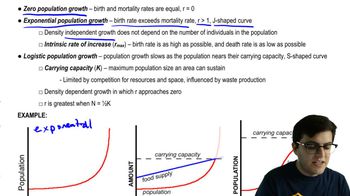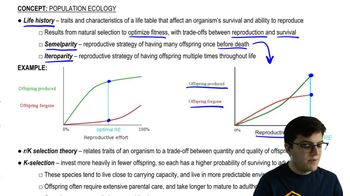- 1. Introduction to Biology2h 40m
- 2. Chemistry3h 40m
- 3. Water1h 26m
- 4. Biomolecules2h 23m
- 5. Cell Components2h 26m
- 6. The Membrane2h 31m
- 7. Energy and Metabolism2h 0m
- 8. Respiration2h 40m
- 9. Photosynthesis2h 49m
- 10. Cell Signaling59m
- 11. Cell Division2h 47m
- 12. Meiosis2h 0m
- 13. Mendelian Genetics4h 41m
- Introduction to Mendel's Experiments7m
- Genotype vs. Phenotype17m
- Punnett Squares13m
- Mendel's Experiments26m
- Mendel's Laws18m
- Monohybrid Crosses16m
- Test Crosses14m
- Dihybrid Crosses20m
- Punnett Square Probability26m
- Incomplete Dominance vs. Codominance20m
- Epistasis7m
- Non-Mendelian Genetics12m
- Pedigrees6m
- Autosomal Inheritance21m
- Sex-Linked Inheritance43m
- X-Inactivation9m
- 14. DNA Synthesis2h 27m
- 15. Gene Expression3h 20m
- 16. Regulation of Expression3h 31m
- Introduction to Regulation of Gene Expression13m
- Prokaryotic Gene Regulation via Operons27m
- The Lac Operon21m
- Glucose's Impact on Lac Operon25m
- The Trp Operon20m
- Review of the Lac Operon & Trp Operon11m
- Introduction to Eukaryotic Gene Regulation9m
- Eukaryotic Chromatin Modifications16m
- Eukaryotic Transcriptional Control22m
- Eukaryotic Post-Transcriptional Regulation28m
- Eukaryotic Post-Translational Regulation13m
- 17. Viruses37m
- 18. Biotechnology2h 58m
- 19. Genomics17m
- 20. Development1h 5m
- 21. Evolution3h 1m
- 22. Evolution of Populations3h 52m
- 23. Speciation1h 37m
- 24. History of Life on Earth2h 6m
- 25. Phylogeny2h 31m
- 26. Prokaryotes4h 59m
- 27. Protists1h 12m
- 28. Plants1h 22m
- 29. Fungi36m
- 30. Overview of Animals34m
- 31. Invertebrates1h 2m
- 32. Vertebrates50m
- 33. Plant Anatomy1h 3m
- 34. Vascular Plant Transport2m
- 35. Soil37m
- 36. Plant Reproduction47m
- 37. Plant Sensation and Response1h 9m
- 38. Animal Form and Function1h 19m
- 39. Digestive System10m
- 40. Circulatory System1h 57m
- 41. Immune System1h 12m
- 42. Osmoregulation and Excretion50m
- 43. Endocrine System4m
- 44. Animal Reproduction2m
- 45. Nervous System55m
- 46. Sensory Systems46m
- 47. Muscle Systems23m
- 48. Ecology3h 11m
- Introduction to Ecology20m
- Biogeography14m
- Earth's Climate Patterns50m
- Introduction to Terrestrial Biomes10m
- Terrestrial Biomes: Near Equator13m
- Terrestrial Biomes: Temperate Regions10m
- Terrestrial Biomes: Northern Regions15m
- Introduction to Aquatic Biomes27m
- Freshwater Aquatic Biomes14m
- Marine Aquatic Biomes13m
- 49. Animal Behavior28m
- 50. Population Ecology3h 41m
- Introduction to Population Ecology28m
- Population Sampling Methods23m
- Life History12m
- Population Demography17m
- Factors Limiting Population Growth14m
- Introduction to Population Growth Models22m
- Linear Population Growth6m
- Exponential Population Growth29m
- Logistic Population Growth32m
- r/K Selection10m
- The Human Population22m
- 51. Community Ecology2h 46m
- Introduction to Community Ecology2m
- Introduction to Community Interactions9m
- Community Interactions: Competition (-/-)38m
- Community Interactions: Exploitation (+/-)23m
- Community Interactions: Mutualism (+/+) & Commensalism (+/0)9m
- Community Structure35m
- Community Dynamics26m
- Geographic Impact on Communities21m
- 52. Ecosystems2h 36m
- 53. Conservation Biology24m
50. Population Ecology
Introduction to Population Ecology
Problem 6b
Textbook Question
With regard to its rate of growth, a population that is growing logistically a. grows fastest when density is lowest. b. has a high intrinsic rate of increase. c. grows fastest at an intermediate population density. d. grows fastest as it approaches carrying capacity.
 Verified step by step guidance
Verified step by step guidance1
Understand the concept of logistic growth: Logistic growth describes how a population grows in an environment where resources are limited. It starts slow, speeds up, and then slows down as the population reaches the carrying capacity of the environment.
Identify the carrying capacity: The carrying capacity (K) is the maximum population size that the environment can sustain indefinitely. It plays a crucial role in logistic growth.
Analyze the growth rate at different densities: In logistic growth, the growth rate changes depending on the population density. It is not constant like in exponential growth.
Determine the point of fastest growth: The fastest growth in a logistic model occurs not when the population is at its lowest or highest, but at an intermediate level. This is because, at very low densities, there are too few individuals to maximize growth, and at high densities, resource limitations slow down growth.
Apply the concept to the options: With the understanding of logistic growth, evaluate which option correctly identifies when a population growing logistically grows fastest.
Recommended similar problem, with video answer:
 Verified Solution
Verified SolutionThis video solution was recommended by our tutors as helpful for the problem above
Video duration:
2mPlay a video:
Was this helpful?
Key Concepts
Here are the essential concepts you must grasp in order to answer the question correctly.
Logistic Growth Model
The logistic growth model describes how a population grows in an environment with limited resources. Initially, the population grows exponentially, but as it approaches the carrying capacity of the environment, the growth rate slows down. This model is characterized by an S-shaped curve, where growth is rapid at first, slows as resources become scarce, and eventually stabilizes.
Recommended video:
Guided course

Exponential Growth vs. Logistic Growth
Carrying Capacity
Carrying capacity refers to the maximum number of individuals that an environment can sustainably support. It is determined by factors such as food availability, habitat space, and competition. As a population nears its carrying capacity, the growth rate decreases, leading to a balance between birth and death rates, which is crucial for understanding logistic growth.
Recommended video:
Guided course

Estimating Earth’s Human Carrying Capacity
Population Density
Population density is the number of individuals per unit area or volume in a given habitat. It plays a significant role in population dynamics, influencing competition for resources, reproduction rates, and mortality. In logistic growth, the growth rate is highest at intermediate population densities, where resources are still sufficient but competition is not yet limiting.
Recommended video:
Guided course

Population Size & Density

 1:17m
1:17mWatch next
Master Population Ecology with a bite sized video explanation from Jason Amores Sumpter
Start learningRelated Videos
Related Practice


































































